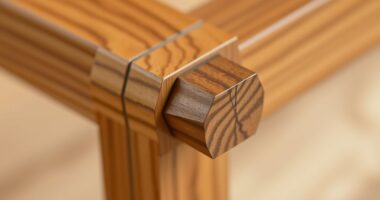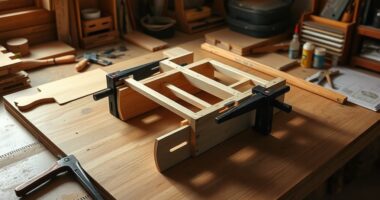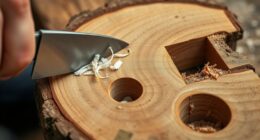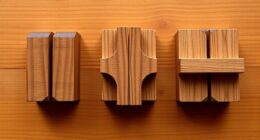To achieve a precision dovetail layout using a simple ratio gauge, start by ensuring your gauge is properly calibrated for accurate measurements. Use it as a visual guide to mark tails and pins, maintaining consistent ratios like 1:6 or 1:8. Focus on measuring carefully and double-checking your marks to reduce errors. When you keep the gauge well-maintained and calibrated, you’ll create stronger, more professional joints effortlessly—stay tuned to discover more tips to perfect your layout process.
Key Takeaways
- Use a well-calibrated ratio gauge to quickly and accurately mark dovetail tails and pins based on consistent ratios.
- Regularly verify and calibrate the gauge against a standard ruler to maintain measurement precision.
- Select an appropriate ratio (e.g., 1:6 or 1:8) for uniform, aesthetically pleasing dovetails.
- Align the gauge carefully during layout to ensure precise transfer of measurements without complex calculations.
- Maintain the gauge properly to prevent inaccuracies, ensuring consistent, high-quality dovetail joints.
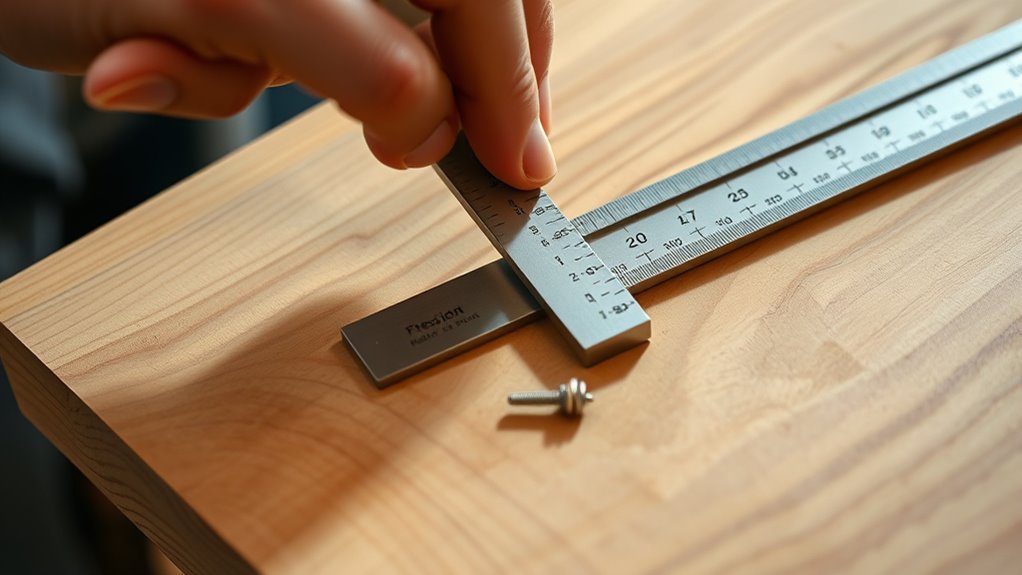
A perfect dovetail layout begins with precise measurements, and using a ratio gauge makes this task much easier. When you’re working on fine woodworking, measurement accuracy is critical to achieving tight-fitting joints that look professional. A ratio gauge simplifies the process by providing consistent, reliable measurements without the need for complex calculations or multiple tools. To get the best results, you must guarantee your tools are properly calibrated. Proper tool calibration guarantees that the ratio gauge’s measurements are accurate, preventing errors that could compromise the fit or strength of your dovetails.
When you set up your ratio gauge, double-check its calibration by comparing it to a known measurement or a standard ruler. This step ensures that what the gauge indicates truly reflects the actual dimensions you need. Once calibrated, the ratio gauge becomes a dependable tool for marking out the tails and pins, allowing you to transfer measurements swiftly and accurately. Using it consistently helps maintain measurement accuracy throughout your project, reducing the chances of misalignment or gaps.
The simplicity of a ratio gauge lies in its ability to translate the proportions of your dovetail layout into a visual guide that you can follow directly on your wood. Instead of manually calculating the angles or relying on complicated templates, you simply adjust the gauge to match the desired ratio—say, 1:6 or 1:8—and then mark your wood accordingly. This method ensures uniformity across all your dovetails, making your joints not only precise but also aesthetically consistent.
Another advantage of employing a ratio gauge is that it minimizes human error. When you’re under pressure or working with small parts, it’s easy to misread measurements or make inconsistent marks. The ratio gauge provides a clear, repeatable reference, so you can focus on your cuts and fitting rather than constantly recalculating or measuring with multiple tools. Just remember, the accuracy of your layout depends heavily on the initial calibration and the care you take in setting the gauge each time. An uncalibrated or poorly maintained tool can introduce inaccuracies that ripple through your entire project.
Additionally, understanding the cost considerations involved in acquiring quality tools like a ratio gauge can help you make informed decisions that fit within your woodworking budget.
Frequently Asked Questions
Can the Ratio Gauge Be Used for Other Woodworking Joints?
You might wonder if a ratio gauge can be used for other woodworking joints. While it’s primarily designed for dovetails, its alternative measurement approach can help with joints that require specific angles or proportions. However, you should check joint compatibility, as some connections need precise measurements beyond the gauge’s capabilities. Overall, the ratio gauge offers versatility, but for best results, verify if it suits your particular joint’s requirements.
What Materials Are Best Suited for Using a Ratio Gauge?
Sure, because your woodworking tools and measurement techniques can only be used on delicate, fancy wood, right? Actually, you’ll find that a ratio gauge works best on softer woods like pine or basswood, where precision matters most. Hardwoods like oak or maple can be more challenging, but with careful handling, your ratio gauge still provides accurate results. It’s versatile, so choose materials that match your project’s needs and your tool’s capabilities.
How Does the Ratio Gauge Improve Dovetail Accuracy?
Using a ratio gauge improves dovetail accuracy by enhancing measurement consistency, ensuring your cuts are precise and uniform. It simplifies the process, helping you develop your skill as you gain confidence in accurate layout work. As you rely on the gauge, you reduce errors and create more professional joints. Over time, this tool becomes essential for mastering dovetail techniques and achieving consistent, high-quality craftsmanship.
Is Special Training Required to Use the Ratio Gauge Effectively?
You might wonder if special training is needed to use the ratio gauge effectively. Generally, the skill level required is minimal; you can learn the basics quickly. Training requirements are simple because the gauge is designed for ease of use, making it suitable for both beginners and experienced woodworkers. With a little practice, you’ll gain confidence and accuracy, enhancing your dovetail layout skills efficiently.
Can the Ratio Gauge Be Used for Curved or Angled Dovetails?
While the ratio gauge shines in straightforward dovetail layouts, its angle adaptation for curved dovetails or angled cuts can be limited. You might find it useful for approximating angles, but for precise curved or angled dovetails, specialized tools or templates are often preferable. With a bit of practice, you’ll discover how to adapt the gauge for simple angled cuts, though complex curves may still require more advanced methods to achieve perfection.
Conclusion
With the ratio gauge in hand, you’ll find dovetail layouts become as smooth as a well-tuned instrument. It’s like having a secret key that unlocks perfect precision every time, turning a daunting task into a straightforward process. Embrace this simple tool, and watch your woodworking skills soar. Soon, your projects will come together with the harmony of a symphony, each joint fitting flawlessly—proof that precision isn’t just a goal, but a craft you master with confidence.


